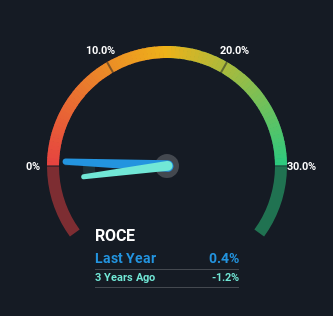- India
- /
- Marine and Shipping
- /
- NSEI:ORICONENT
Oricon Enterprises (NSE:ORICONENT) Could Be Struggling To Allocate Capital
What underlying fundamental trends can indicate that a company might be in decline? When we see a declining return on capital employed (ROCE) in conjunction with a declining base of capital employed, that's often how a mature business shows signs of aging. This indicates the company is producing less profit from its investments and its total assets are decreasing. Having said that, after a brief look, Oricon Enterprises (NSE:ORICONENT) we aren't filled with optimism, but let's investigate further.
What Is Return On Capital Employed (ROCE)?
If you haven't worked with ROCE before, it measures the 'return' (pre-tax profit) a company generates from capital employed in its business. Analysts use this formula to calculate it for Oricon Enterprises:
Return on Capital Employed = Earnings Before Interest and Tax (EBIT) ÷ (Total Assets - Current Liabilities)
0.004 = ₹49m ÷ (₹14b - ₹1.3b) (Based on the trailing twelve months to September 2023).
So, Oricon Enterprises has an ROCE of 0.4%. Ultimately, that's a low return and it under-performs the Shipping industry average of 15%.
Check out our latest analysis for Oricon Enterprises

Historical performance is a great place to start when researching a stock so above you can see the gauge for Oricon Enterprises' ROCE against it's prior returns. If you'd like to look at how Oricon Enterprises has performed in the past in other metrics, you can view this free graph of past earnings, revenue and cash flow.
What Does the ROCE Trend For Oricon Enterprises Tell Us?
In terms of Oricon Enterprises' historical ROCE movements, the trend doesn't inspire confidence. Unfortunately the returns on capital have diminished from the 2.5% that they were earning five years ago. Meanwhile, capital employed in the business has stayed roughly the flat over the period. Companies that exhibit these attributes tend to not be shrinking, but they can be mature and facing pressure on their margins from competition. If these trends continue, we wouldn't expect Oricon Enterprises to turn into a multi-bagger.
On a side note, Oricon Enterprises has done well to pay down its current liabilities to 10.0% of total assets. That could partly explain why the ROCE has dropped. What's more, this can reduce some aspects of risk to the business because now the company's suppliers or short-term creditors are funding less of its operations. Some would claim this reduces the business' efficiency at generating ROCE since it is now funding more of the operations with its own money.
The Key Takeaway
In the end, the trend of lower returns on the same amount of capital isn't typically an indication that we're looking at a growth stock. But investors must be expecting an improvement of sorts because over the last five yearsthe stock has delivered a respectable 77% return. Regardless, we don't feel too comfortable with the fundamentals so we'd be steering clear of this stock for now.
On a final note, we found 5 warning signs for Oricon Enterprises (1 doesn't sit too well with us) you should be aware of.
If you want to search for solid companies with great earnings, check out this free list of companies with good balance sheets and impressive returns on equity.
New: AI Stock Screener & Alerts
Our new AI Stock Screener scans the market every day to uncover opportunities.
• Dividend Powerhouses (3%+ Yield)
• Undervalued Small Caps with Insider Buying
• High growth Tech and AI Companies
Or build your own from over 50 metrics.
Have feedback on this article? Concerned about the content? Get in touch with us directly. Alternatively, email editorial-team (at) simplywallst.com.
This article by Simply Wall St is general in nature. We provide commentary based on historical data and analyst forecasts only using an unbiased methodology and our articles are not intended to be financial advice. It does not constitute a recommendation to buy or sell any stock, and does not take account of your objectives, or your financial situation. We aim to bring you long-term focused analysis driven by fundamental data. Note that our analysis may not factor in the latest price-sensitive company announcements or qualitative material. Simply Wall St has no position in any stocks mentioned.
About NSEI:ORICONENT
Oricon Enterprises
Engages in manufacturing, trading, and sale of metal and plastic closures, and liquid colorants in India and internationally.
Solid track record with adequate balance sheet.
Market Insights
Community Narratives



